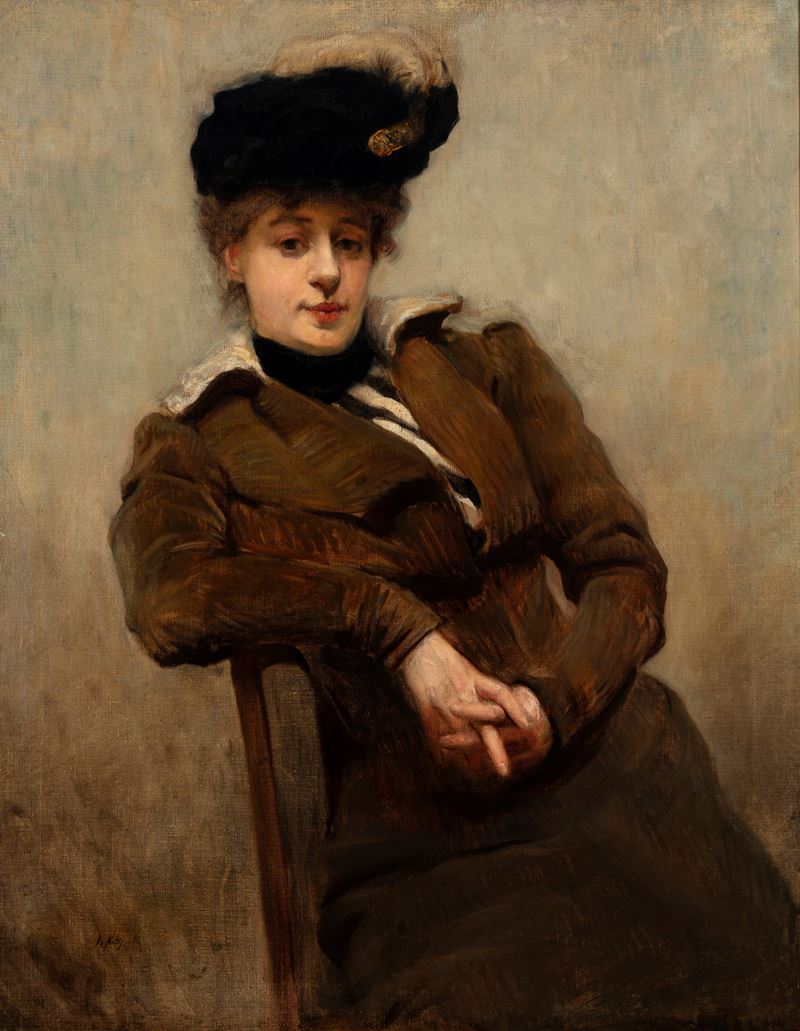Information
cm 91 x 73
signed lower left: De Nittis
Specialist Notes
The painting belonged to General Pietro Minetti who - resident in Milan - in 1957 (March 13) sold it to Mario Villa, born in 1898, an electrical engineer and founder of Passoni and Villa Spa. By descent to the current owners. At an unspecified time - probably in the 1950s - the painting was re-stretched: the reflectographic examination to which it was recently (May 2018) subjected revealed the presence of imprints from the old stretcher, in particular a crosspiece. It was during the re-stretching that the painting, perhaps to ensure its state of conservation in the aftermath of the world conflict, was restored, as a result of which it now appears to be characterised by a very thin pictorial film, at times worn in the background - as revealed by observation under the microscope - a background on which the signature stands out clearly, probably re-stretched during the restoration itself. The reflectographic examination allowed us to visualize the compositional layout executed in one go and with a grease pencil. The painting is accompanied by an authentic written document by Giuseppe Luigi Marini, dated 1992. The painting Portrait of a Lady is an authentic and valuable work by Giuseppe De Nittis (Barletta 1846 - Saint Germain-en-Laye 1884). Educated at the Institute of Fine Arts in Naples, a city where he moved in 1861, having lost both parents, Giuseppe was expelled from the Institute just three years later and, having met Adriano Cecioni (a member of the Tuscan Macchiaioli group), Marco De Gregorio and Federico Rossano, he founded with them the so-called "Scuola di Resina", named after the place where they practiced painting en plein air. During 1867 he passed through Paris, stopping in Turin and Florence. Having met the famous painter Meissonier and the powerful merchant Goupil in the French capital, he settled there permanently in 1868, marrying Leontine Gruvelle and shortly thereafter beginning an extraordinary professional rise, offering the public of art lovers refined city views animated by passers-by. He was thus identified as the "painter of modern life" portrayed in literature by Charles Baudelaire. The reality that surrounds the artist, the painter of modern life, is in fact a continuous source of inspiration for him, whether he is faced with the elegant girl sitting on a bench in the woods, or the Amazons, or the lithe washerwomen along the Seine. The graceful forms, the sparkling effect are components that De Nittis shares with his compatriot Giovanni Boldini, as are the pictorial subjects successfully tackled by both. De Nittis, however, is inclined, at the same time, to a less conventional pictorial research, which he matures from his proximity to the Impressionists, towards whom he does not fail to demonstrate a sincere esteem and an indisputable poetic affinity. As is known, Degas, Monet and Manet are assiduous frequenters of the weekly appointments at the De Nittis house, moments narrated admirably by the de Goncourts in their Journal. In our opinion, the present Portrait, previously unpublished, is placed in the final stretch of De Nittis's brief journey, alongside The Visit to the Marzotto Collection (P. Dini, GL Marini, De Nittis. Life, Documents, Painted Works , Turin 1990, no. 977) and the many life-size portraits of female figures, mostly made in pastel, which, presented in an exhibition at the Cercle des Mirlitons in Place Vendome, brought the artist great success. In front of the triptych of the Races at Auteuil (Rome, Galleria Nazionale d'Arte Moderna) contemporary critics praised the artist, calling him "a champion", "a true Parisian, no matter where he came from", capable of generating "beautiful creatures, full of life and movement" (J. Buisson, in "Le Corrispondant"). While Alfred de Lostalot in the "Gazette des Beaux-Arts" enthusiastically writes that "Mr. De Nittis paints comme il faut le monde; his models are good people and he knows how to preserve their appearance as they are...". The protagonist of our painting naturally presents herself to the viewer, sitting on a chair, while a slight twist of the bust allows her to rest her arm on the back and to slide her soft forms towards an almost frontal plane that is not frontal. Hence the sense of restrained movement that leads the beautiful model to cross with apparent ease underlined by the intertwining of her hands, a compositional style that we also find in the beautiful etching, dated 1881, Etude dans mon jardin (Barletta, Pinacoteca Comunale). It is evidently a portrait, not a female image captured extemporaneously from life with a rapid and lively pictorial technique, like the many faces of girls that crowd this final stretch of the journey of the Apulian master - see Young woman with hat. On the lookout or Bust of a woman with fringe (Dini-Marini, nos. 782 and 974); but although "meditated", our painting has the compositional certainty typical of the master from Barletta who uses - as has also been revealed by the reflectographic examination - rapid strokes traced in grease pencil. The choice of clothing, a tout-de-meme tailleur, that is, a two-piece made with the same light brown fabric, gives a certain sportiness to this graceful Parisian who does not, however, renounce a touch of coquetry in the shiny black velvet hat and in the black and white striped blouse that can be glimpsed from the open jacket.
For authenticity Francesca Dini
Florence, July 12, 2018
Condition report
Suggested lots
Caricamento lotti suggeriti...















